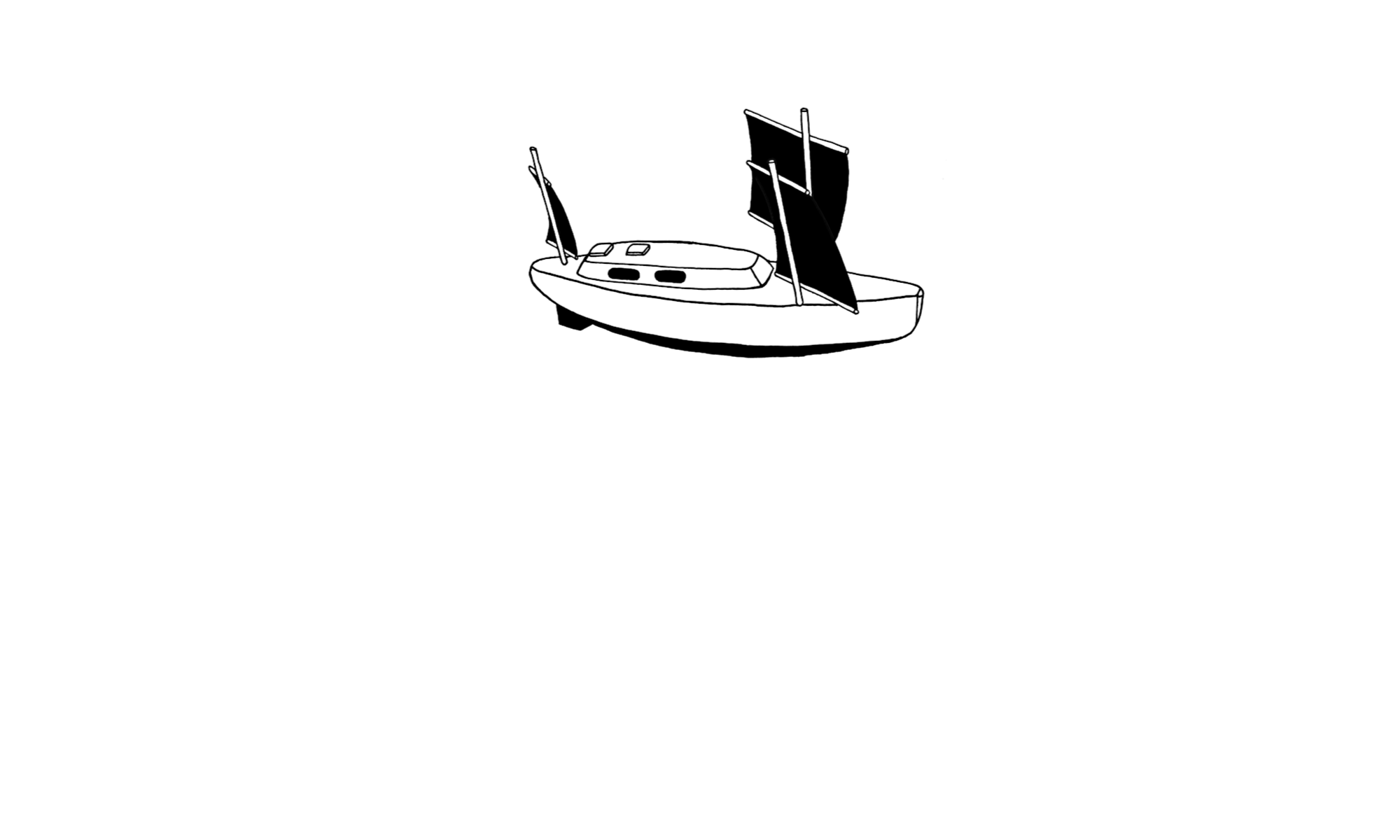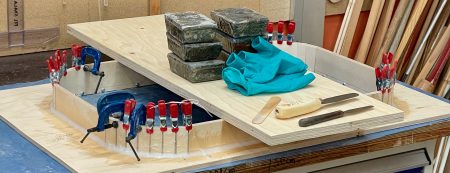New post on Youtube
To be continued…
Regards Yrvind

Welcome to Yrvind´s website: small boat designer, builder, sailor & writer
New post on Youtube
To be continued…
Regards Yrvind
Hello friends.
Progress is good due to sleepless nights. The nights that keep me awake brings good ideas.
The bow centerboard is a good idea but it comes with a cost. Maybe 50 kilos and space and controol lines. I think I can live without it relying on near vertical chine runners. I call them chinerunners becouse I belive they work in conjunction with the hull creating a kind of fluid fence redirecting the water that tries around the hull to lee creating a windward force. This is of course specultion. The effect I imagen is similar to the effect of a spoon held under running water with the concave side up. The spoon makes the water splash all over. As a child I found the phenomen interesting.
If you watch the youtube video “Yrvind in Stockholm Archipilago” you will see my yellow chinerunner boat sailing. It was longer wider heavier had less sail area than Matt Laydens Paradox and heeled much less. A chinerunner with horisontal chinerunners should heel to get the chinerunner effect. I sailed the boat in Sweden, I sailed her from Ireland to Madeira, I sailed her from Madeira to Martinique. She did not go well to windward due to lee healm. Very fortunately the last few houers of the many thousands of mile long sail sailing into the two mile long fjord leading to Le Marin I had a gale force head wind gusting 50 knots. Now the yellow boat was in her element. She heeled over and went to windward like a rocket. I nearly missed that experience. I have also sailed daily on Matts Paradox for a month and a few times on Enigma.
Now I hope that the Exlex prototype will guide me to a good position of the chinerunners.
I will take the lines of the bow of the Yellow boat of 2011 mirror them and mowe them apart filling the middle with a prism. The prism is straight edged. Along the edge there will be the chinerunners. I can mowe them back and forth on the prototype untill I find a good balance.
The rope pulling the airlock hatch against the hatch gasket need tension. It have taken me some time to make it work properly. First try did not work well. Secound try work well but was complicated. The present third works well and is simple as shown in the wideo below.
The video also tells that I am now close to sailing.
Thanks to Mario of Hamburg who kindly paid for my Corona test.
To continue…
Regards Yrvind.
The lids for the airlocks have to be very good, waterproof and such tings.
For me that means thick gaskets and large radius. I use closed foam EPDM rubber. I do not use a conventional hinge with a fixed axes. That way I can tension the lid all around.
The present opening is a bit larger than previus ones 40X60 cm with radius of about 11 cm.
The first try showed that there was to much friction in the tensening line, that is tensioned with a home made over the center device.
I am now building rollers for the line, 7 in all to reduce the frictione. I do not have much space in the upper part where the lid turns so this will take some time.
Also the tire on my bicycle was getting to worn a bulge made the wheel bumpy. Before I could get a new tire there was a puncture. I was talking to a man before leaving work and before knowing there was a puncture. He left in his car. I turned to leave on my bike but there was no air. Had I known that I would have asked him for a ride. That would have saved me a 40 minutes walk. Next day he told me that he had a puncture on his car tire. Odd!
I am still trying to get a certificate that I had 2 vaccinations in order to fly to my boat on Madeire. The doctor told me that the policy is to cure sick people not to help people to get sailing. I am working on this bureaucratic problem. hopefully finding a solution soon because I am eager to go sailing the big blue deep endless eternal sea.
Video below.
To be continued…
Regards Yrvind
To increase seaworthiness I am adding an airlock. There is a video below showing the start.
I use the fore and after peak as airlocks.
I will fit these relatively small spaces with two watertight hatches in series.
Captain Nemo had one on his submarine Nautilus 1869 so the idea is not new. Nowadays its common on submarines and spaceships but not on small cruisers.
I endeavor to make my small cruiser as seaworthy as possible. From the hatches I can reach the masts and sails. Those I do not have to be on deck to reef and unreef. A good thing if I should get old and week. In high latitudes there is the possibility of waves filling the fore or after peak when the hatches are open. Now with the peaks in airlock mode no water will enter the living compartments. I can close the hatch, pump out all the water get dry and enter the living compartment.
1973 I left Sweden in an attempt to round Cape Horn in Bris a 20 feet light displacement double ender. The first part of the route took me north of Scotland, west of Ireland similar to my 2020 sail. For several weeks the weather was heavy. At one time a wave hit the beam with such a force that the boat was flung a long distance to lee. When looking out I noticed that the logline was wrapped around the hull. At an other time one dark night when the wind increased I went up to the mast to reduce sail. Looking back I saw an enormous breaker. I only just had time to sit down cross my legs and arms around the mast, because I was sure that when the breaker hit my small boat she would capsize. But as miracle she just held her course and took of in an enormous surf leaving a monster wake behind her for what seamed a very long time.
When I was back below my arms and back ached.
In the beginning of 1974 I left Mar del Plata Argentina bound for Cape Horn. After a few weeks of sailing south Bris was capsized by a wave hitting her beam. The wind was much less strong than the ones I had had in the Northern North Atlantic. A week later. It was early in the day the wind suddenly increased to hurricane force. I did not worry to much because such sudden winds usually die down quick. Not this one. It just kept blowing with the same intensity for hour after hour. All sails was down and a drouge was streamed om a 150 meter long line. Despite that Bris was pichpoled.
I designed a more seaworthy boat, but it was a long way to my mothers basement where I had built Bris.
An important part was the ventilation system. When Bris had been upside down water had entered. To prevent that from happening again I made the air enter at the bottom of the boat. When the boat is upside down the boats bottom is up in the air hence no water can enter in a capsize or pitchpole. The system works very well and I have written more about it in the manifesto.
Now 2021, 47 years later I am still finding ways to make my boats more seaworthy.
I now had two shots of vaccin I hope to be back in Porto Santo Madeira very soon to do some sailing in the deep, big, blue, eternal, endless, ocean, before I continue working on the Canoe Yawl in the autum. But even though I am vaccinated it seams that I have to get a corona test and that will cost € 200. I try to find a cheaper way.
Below a picture of the what is the start of the coaming.

The airlock video belov. Please comment, subscribe, donate and enjoy.
To be continued…
Regards Yrvind.